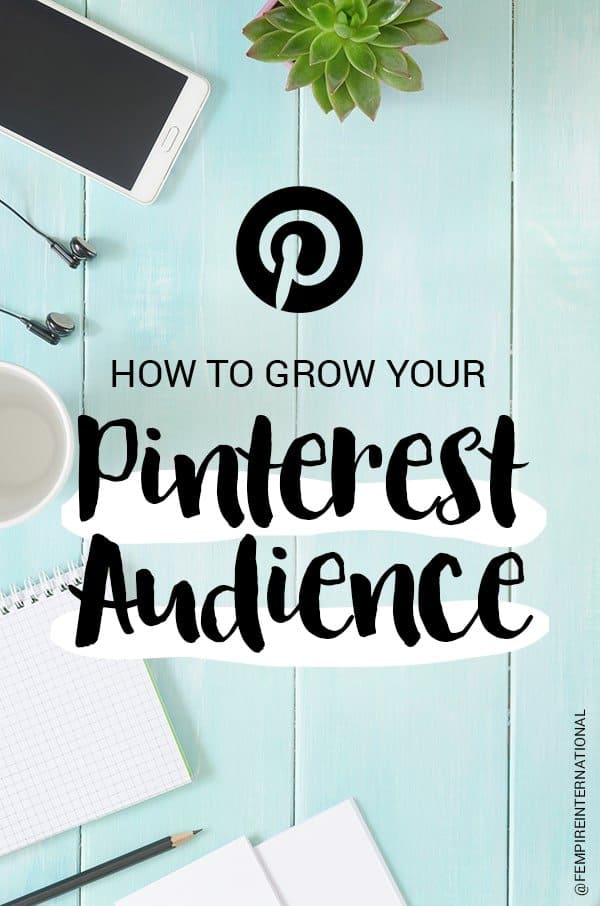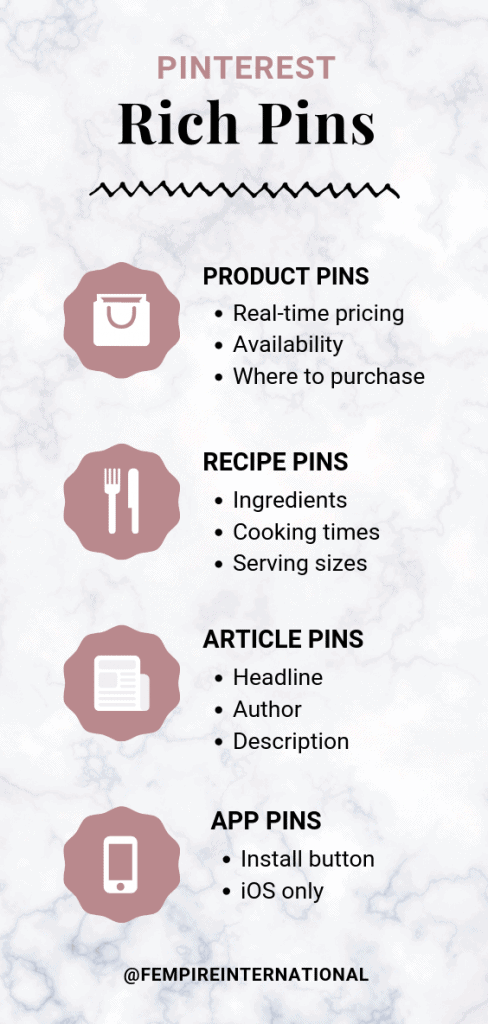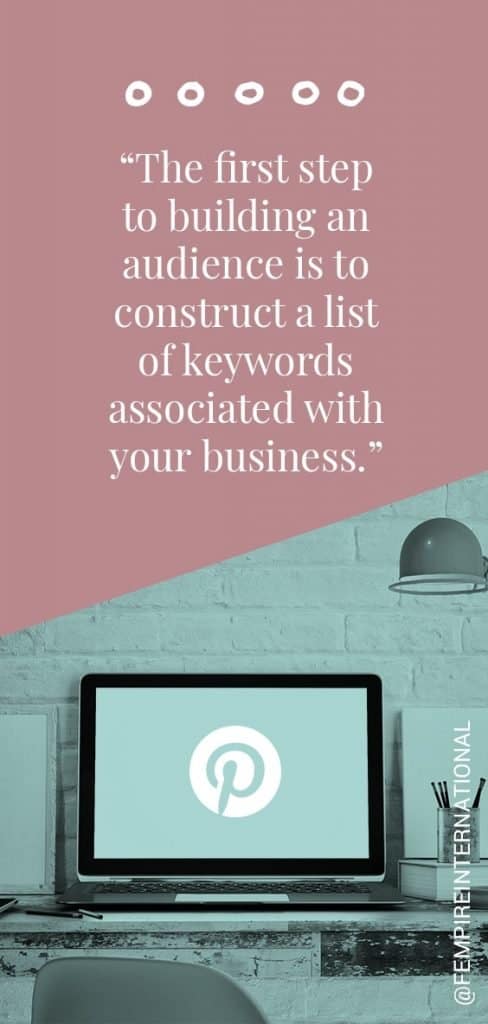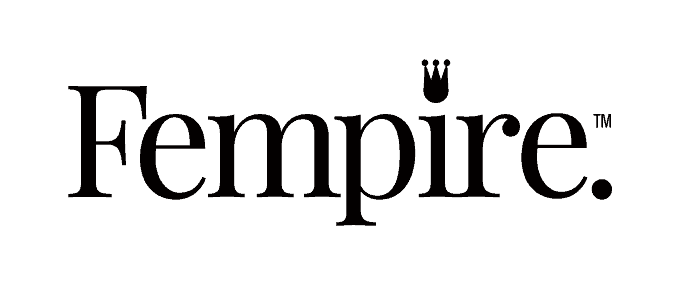So, you’ve heard all the wonderful advice about how you need to be using Pinterest to grow your business’s audience, and you’ve created a Pinterest account…but you’re not sure what to do next. How do you actually start gaining traction and building an audience?
Before we get into how you can grow your Pinterest audience for your business, the very first step is to make sure your Pinterest account is actually a Business account – not a Personal one. If it is a Personal account, it’s easy to upgrade to a Business account. Simply go to the Pinterest Help Centre and follow the instructions.

So, now that you’ve got a Pinterest Business account, let’s get started.
Keywords
The first step to building an audience is to construct a list of keywords associated with your business.
Keywords are ideas and topics that define what your business is about. Using keywords relevant not only to the content you’re posting, but also to your business will make it easier for people to find your posts.
Once you’ve armed yourself with your list of keywords, write your profile ‘About’ description. Make sure it’s packed with the most relevant words to your business. This will help your profile stand out on top when users search for those keywords.
The first step to building an audience is to construct a list of keywords associated with your business.
Profile Image
You’ll also want to ensure your profile picture aligns with your brand. The best approach is to use your logo as your profile image, or your face if you’re a personal brand.
Claiming Your Website
At this stage, it’s also important to verify your website’s authenticity by claiming your website. This could be a bit tricky for those that are not so tech savvy, but Pinterest provides a very helpful guide to ensure it’s a smooth process.

Rich Pins
While we’re in the techy side of things, let’s have a chat about Rich Pins. Now, there are 4 types of Rich Pins:
- article
- recipe
- product; and
- app.
The benefit of using Rich Pins is that they show more information about the pin directly underneath it. This fosters an improved viewer experience because they don’t have to click on the pin to see who its from or what it’s about.
But your Pinterest account won’t come automatically hooked up with Rich Pins, you’ll have to add them in a similar process to claiming your website. However, Pinterest have once again come in with the save and have put together a very helpful guide on how to get set up with Rich Pins.
So, now that we’ve got that techy (but important) stuff out of the way, let’s move on to getting your account full of content.
Pins and Boards
A thing you need to know about Pinterest is the difference between Pins and Boards. Everything you post on Pinterest, the images you upload and the content you see on the platform, is referred to as Pins. Boards on the other hand, are a way to organise your pins. Think about it like having multiple cork pin-up boards hanging in your office – one board for every facet of your business. Every time you find an inspirational image, you cut it out and pin it to an appropriate board. Pinterest may be digital, but it operates in the same fashion. You find or create Pins, and then stick them to your Boards.
Creating Boards
So, before you can start pinning, you need to create boards that are relevant to your business. Let’s start out by brainstorming names for those boards. Go back to that list of keywords and put together some short but fun names – ideally you want them to contain a keyword, sound interesting, but not be too long and dry! Easy peasy!
For example, if you’re a landscaping company, some good board ideas could be:
- Inspirational Gardens
- Cute Cottage Gardens
- Gardening Tips and Tricks
Try to avoid simple, broad and generic terms like ‘Garden Images’, ‘Gardens’, or ‘Advice’. Get creative and have a bit of a play around with your wording. But fear not, your board names aren’t set in stone. If you want to change them down the track, you can.

Initially start out with between 10 to 20 boards until you get into the swing of things. You’ll find that along the way you’ll come across ideas for new boards – add these in because they will help build your profile!
Once you’ve created your boards, you’ll want to pack each board description with keywords that are associated with its board name.
Now, when I say pack the description with keywords, I’m not telling you to use your character limit up on stuffing as many keywords as possible. The description still needs to make sense and sound organic. Effectively incorporating your keywords into your board description will improve your SEO and help your boards become more discoverable on the platform.
A little tip is to search the board name in Pinterest and look at the keywords that appear under the search bar. These belong in your description. For example, a search of ‘Inspirational Gardens’ resulted in a number of keywords, including ideas, landscapes, and front yard.
Once you’ve created your boards, you’ll want to pack each board description with keywords that are associated with its board name.
Now that you’ve figured out your board names and created them, it’s time to get pinning!
Pinning Content
The general rule of thumb is to go 50/50 – 50% your own content, and 50% content from other users.
With this in mind, you should aim to pin between 20 to 40 pins a day. You want to make sure your content is getting out there and that you’re an active member of the Pinterest community, but you don’t want to inundate your followers.
Now, I know that the thought of pinning 40 pins a day, 7 days a week, is an overwhelming one. But fear not! There are tools out there that streamline and simplify this process so that it only takes a couple hours to schedule pins for the whole week.
The general rule of thumb is to go 50/50 – 50% your own content, and 50% content from other users.
Some popular scheduling tools for Pinterest include Tailwind and Buffer. We actually have an ‘over-the-shoulder’ training on using Tailwind for Pinterest and exploding your reach inside the academy. #sneakyplug
At this stage in your Pinterest page development, you will start to see your monthly views increasing and engagement taking place.
Creating and Designing Pins
If you get stuck on producing your own pins, think about repurposing content. Take a look at old blog articles you have sitting on your website. Could you create a few pins per post that link back to your article? Some suggestions are:
- Title Pins: pins that include the title of your article
- Quote Pins: pins with a relevant quote
- Product Placement Pins: pins showing your product being used
- Image Pins: pins with a beautiful image only
- Infographic Pins: pins that combine text and images to explain a concept
All of the pins you create should link back to a relevant place on your website, or to your other social media profiles.
For example, you could create a pin that leads viewers to a video you created on YouTube.
If you’re unsure how to actually design your pins, then look no further than Canva. Canva is a user friendly and free design tool that a magnitude of Pinterest users rave about.
Wrap Up
Pinterest can be a great way to increase traffic to your website but the key to being successful is to share fresh content consistently.
So now over to you! Let me know in the comments if you’re using Pinterest to grow your audience and increase traffic to your website. Are you seeing success?
Anna Gratte is a marketing intern at Fempire. She has a keen interest in social media and content creation and is passionate about creating engaging content that inspires women to achieve success and live a fulfilled life.




Nice work Anna! Very informative…gotta up my Pinterest game!
Thanks Jo!
Great article Anna, thanks for sharing. I’ve started a Pinterest account for our business & am trying to work out the best way to use it.
Thank you, Tanya! It’s wonderful to hear that you’ve started a Pinterest account – I wish you the best of luck and I can’t wait to see your audience grow! If you need any help at all please don’t hesitate to post on the Fempire Academy forum, just make sure you tag me @AnnaGratte and @Kate De Jong, she’s full-bottle on Pinterest too! xx
Really interesting helpful article Anna! Mx
Thank you, Marnie!